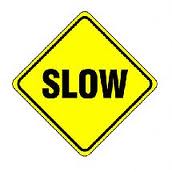3G is still just a pipe dream, yet too many designers still design mobile websites and mobile apps, with the assumption that everyone has a state-of-the-art smartphone, with a fast 3G connection. So how do you solve the problem?
We’re asked quite regularly what makes a good mobile website, and normally after half an hour of saying usability, usability, usability we get bored and say speed. Speed of course is inextricably linked to usability, but for some reason not everyone understands this, apart from those with a vested interest in the field like Gomez and Keynote.
We’re all far too used to broadband delivering us huge multimedia experiences on our PCs at work and home, it’s hard to find a site that doesn’t have video on theses days, and that’s not just normal video many sites are moving to HD video so that their products and services look as good on the screen as they do in real life.
The result of all this high-bandwidth, no site too big approach, is that web designers have become lazy. Back in the mid-90s any good web designer worth their salt kept one eye on the design, and one eye on the file size. There was no point in producing a fine looking website, if the damn thing took 10 minutes to load on a 28.8k modem. Now we’re all buzzing around at 8Mbps (that’s 284 times faster than a 28.8k modem) we don’t really care about speed, and designers have become fat on bandwidth.
Unfortunately on mobile you’re back in the ’90s despite the claims of the network providers. There are still too many mobile designers who approach mobile building with the attitude that everyone is on 3G. Wrong. Most of the time the average speed is a lot less than 3G. Just look at our recent story on the recent Broadband results from Broadbandgenie.co.uk. Their figures showed that the average speed for mobile broadband is still below 1.2Mb and that’s also going to apply to mobile, and let’s not forget this is the average speed, which means it goes a lot slower.
Unfortunately for publishers it’s also impossible – unless you’re a network operator – to know what the connection speed is. You don’t know if someone is connecting via wifi, via 3G or if they’re in the middle of the highlands, where it’s quicker to rely on a carrier pigeon for your news.
The only solution is to think small and where necessary to offer alternatives.
Think small, means reducing your graphics to the bare minimum, watching the page weight, and using standard HTML to replace graphics where possible. We like to test everything on a phone with 3G connections switched off, and with just GSM selected. Better still see if you can find an old phone that was invented in the bad old days, we’ve got a draw full of them for just this purpose.
Then there’s the alternatives. SMS loathe it or like it is still a quick and effective way to get information to and from a mobile user. It’s also – for many – easier to do than getting to a mobile site.
[ad name=”Google Text half banner advert “]
